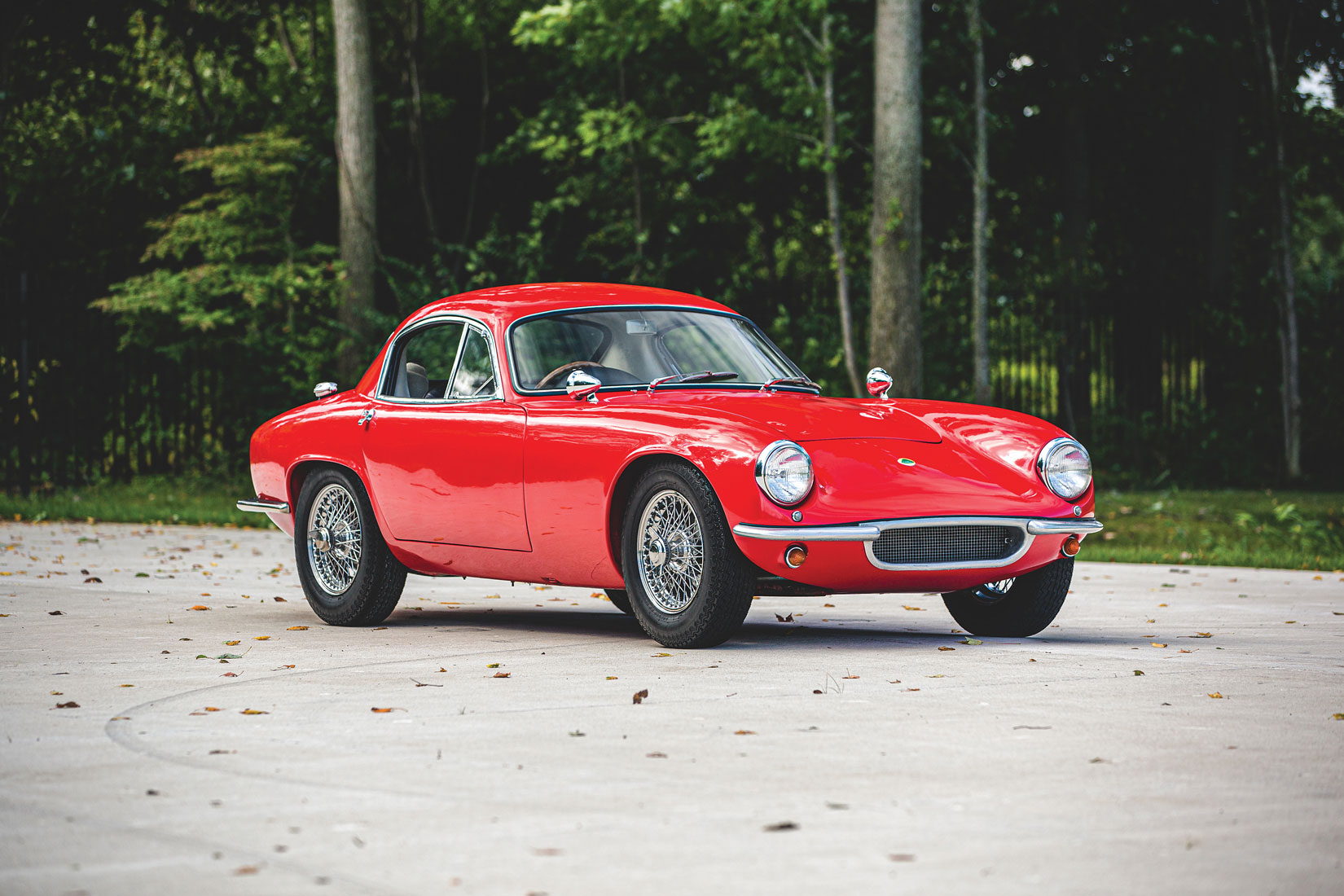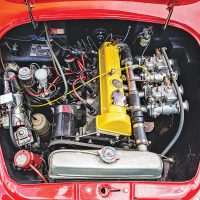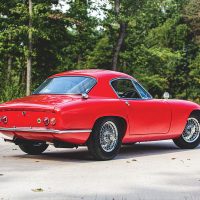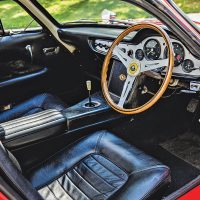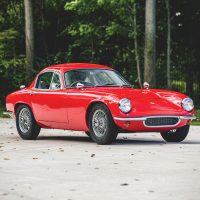- The important origin of the Lotus street car
- Desirable Series II model with ZF close-ratio gearbox
- Coventry Climax FWE engine with twin Weber carburetors
- Cosmetically restored; engine rebuilt for former owner by Tony Mantle
SCM Analysis
Detailing
| Vehicle: | 1962 Lotus Elite Series II |
| Years Produced: | 1957–63 |
| Number Produced: | 1,030 |
| SCM Valuation: | $70,500 |
| Chassis Number Location: | Plates on driver’s side of scuttle |
| Engine Number Location: | Right side of block |
| Club Info: | Club Elite/Lotus Elite World Register |
| Website: | http://www.lotuseliteworldregister.com |
| Alternatives: | 1959–62 DB Le Mans, 1962–67 Matra Djet, 1962–74 Lotus Elan |
| Investment Grade: | C |
This car, Lot 1184, sold for $72,800, including buyer’s premium, at RM Sotheby’s Elkhart Collection sale in Elkhart, IN, on October 23, 2020.
The Type 14 Elite was the first road coupe from the fertile mind of Colin Chapman, following the open Six and Seven roadsters and a series of successful all-enveloping sports racers starting with the 1954 Mk VIII. Chapman’s approach was always to “add lightness,” achieved for the Elite by pioneering an all-fiberglass monocoque with only localized steel reinforcement. The windscreen hoop incorporated door pillars and jacking points, and “skis” supported the engine and front suspension. Power came from the 1,216-cc aluminium Coventry Climax SOHC engine that had originated as a power unit for fire pumps.
Though it won plaudits for its sparkling performance and handling, early cars inevitably suffered reliability problems, with differential mounting issues and a tendency for the rear suspension mounts to pull out. That improved with the Series II, whose bodies were molded by the Bristol Aeroplane Company rather than Maximar, featuring detail improvements such as wishbones to locate the rear suspension struts instead of cranked single doglegs. Chapman, always looking for more profit, replaced the Elite with the steel-backbone-chassis Elan in 1962.
At least 60% are known to survive, aided by an enthusiastic club network and good parts supply, including replacement body shells. Elites remain devastatingly effective historic racers. If you’re ever offered the chance to sample one, jump at it.
Bankrupt in Indiana
This one piqued our interest because the few lines above comprised the entire catalog entry, apart from the exhortation that this was “a fine example to be driven and enjoyed.” Perhaps. An RM Sotheby’s flack subsequently told me, “All the cars in the Elkhart Collection were very well-kept mechanically, everything ‘on the button,’ and the Elite was no exception.”
This 281-car menagerie was being disposed of in its entirety due to a bankruptcy sale mandated by the U.S. government, to satisfy a $98 million judgment, hence no reserve was stipulated on any of the items, as they all had to sell. Though this Elite may have been “on the button,” it sadly appeared to have been unused for the 12 years it mostly sat in a warehouse at Elkhart Municipal Airport in Indiana.
Interlogic Outsourcing Inc. founder Najeeb Khan bought the car for $91,260 at Bonhams’ Quail Lodge auction in 2008, when it was pictured wearing race numbers and showing 50,406 miles, and the relevant bit of that catalog entry says: “Has been in the caring hands of a Lotus collector for almost 30 years. [Motoring historian] Doug Nye noticed it at a meet in Great Britain in 1980, and noted that the red Series II had a gleaming engine bay and chrome wire wheels. Instead of the normal MG gearbox, this Elite has the superior ZF close-ratio box, and the Climax engine boasts twin Weber carburetors rather than the SUs. The FWE engine has been rebuilt by the famous Tony Mantle.”
There’s an English concours plaque on the dash dated 1979, but not long after Nye saw it in the U.K. it must have come to the U.S., where the Lotus Elite World Register’s Mike Ostrov saw it, “In the ’80s in the Sacramento, CA, area, with David Springett.”
Unused for a decade
Having inspected the car in California in 2008, we said: “Very good paint, fair-to-good chrome, worn finish on alloy front bumpers. Poor door fit — but that’s not surprising. Good interior has re-covered seats, some scratches on dash face, glue stains under steering-wheel emblem, and heavily stained shift knob.” A condition assessment of 3- seems a bit harsh, even if it had chrome wires (an option when new) when most of them had painted wheels.
Now showing 50,407 miles, it’s a shame it’s been unused. No car likes standing for long periods, and these are sublime to drive. Their light weight — just 1,450 pounds — is about the same as a Caterham Seven, a clue to why they handle so instinctively well. Changing direction in an Elite is almost telepathic. The ZF box is still only a 4-speed, but it’s a nicer change than the standard transmission (which we never complain about when it’s in an MGA). More to the point, its closer ratios better suit the featherweight Elite.
These are little buzz-bombs, however. The tiny 1,216-cc Coventry Climax FWE SOHC inline-4 makes around 100 horsepower when fitted with twin Webers, as is the case here (or 75 hp with the standard single SU). This generates an annoying period of resonant vibration through the all-fiberglass monocoque at around 4,500 rpm, but you can drive around that with more revs — and still get 30 mpg. Only about 1,030 of these little gems were built, and most are accounted for via the Elite World Register.
Spending other people’s money
Unlimited fundage (even if it technically belonged to other people) might explain why the price paid in 2008 looked rather strong, and as we can see by more-recent prices of Elite S2s, some with ZF boxes, had settled at just under $80k. This car sold for a little less, in line with the continued downward trend in the values of most collector cars, but it’s a healthy price in today’s market. Let’s call it correctly sold this time.
Interestingly, in the same sale a few lots later was an Elite race car, which Ostrov says “was on its second or third CBU (Composite Body Unit)” and sold on a bill of sale. You’d expect that one to be a little cheaper, and sure enough, it fetched $67,200.
It looks to me as if our subject car was bought high 12 years ago by a collector eager to accumulate cars and with no shortage of money at the time. An adjustment to its true value has not been in this car’s favor. Losing a few thousand here appears to be the least of Mr. Khan’s worries, though. When the market is distorted by external forces, it tends to correct itself in the end. ♦
(Introductory description courtesy of RM Sotheby’s.)
